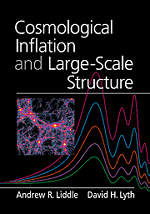Book contents
- Frontmatter
- Contents
- Frequently used symbols
- Preface
- 1 INTRODUCTION
- 2 THE HOT BIG BANG COSMOLOGY
- 3 INFLATION
- 4 SIMPLEST MODEL FOR THE ORIGIN OF STRUCTURE I
- 5 SIMPLEST MODEL FOR THE ORIGIN OF STRUCTURE II
- 6 EXTENSIONS TO THE SIMPLEST MODEL
- 7 SCALAR FIELDS AND THE VACUUM FLUCTUATION
- 8 BUILDING AND TESTING MODELS OF INFLATION
- 9 THE COSMIC MICROWAVE BACKGROUND
- 10 GALAXY MOTIONS AND CLUSTERING
- 11 THE QUASI-LINEAR REGIME
- 12 PUTTING OBSERVATIONS TOGETHER
- 13 OUTLOOK FOR THE FUTURE
- 14 ADVANCED TOPIC: COSMOLOGICAL PERTURBATION THEORY
- 15 ADVANCED TOPIC: DIFFUSION AND FREESTREAMING
- Appendix: Constants and parameters
- Numerical solutions and hints for selected examples
- References
- Index
8 - BUILDING AND TESTING MODELS OF INFLATION
Published online by Cambridge University Press: 05 June 2012
- Frontmatter
- Contents
- Frequently used symbols
- Preface
- 1 INTRODUCTION
- 2 THE HOT BIG BANG COSMOLOGY
- 3 INFLATION
- 4 SIMPLEST MODEL FOR THE ORIGIN OF STRUCTURE I
- 5 SIMPLEST MODEL FOR THE ORIGIN OF STRUCTURE II
- 6 EXTENSIONS TO THE SIMPLEST MODEL
- 7 SCALAR FIELDS AND THE VACUUM FLUCTUATION
- 8 BUILDING AND TESTING MODELS OF INFLATION
- 9 THE COSMIC MICROWAVE BACKGROUND
- 10 GALAXY MOTIONS AND CLUSTERING
- 11 THE QUASI-LINEAR REGIME
- 12 PUTTING OBSERVATIONS TOGETHER
- 13 OUTLOOK FOR THE FUTURE
- 14 ADVANCED TOPIC: COSMOLOGICAL PERTURBATION THEORY
- 15 ADVANCED TOPIC: DIFFUSION AND FREESTREAMING
- Appendix: Constants and parameters
- Numerical solutions and hints for selected examples
- References
- Index
Summary
In the preceding chapter we were on firm ground. The calculation of the vacuum fluctuation uses basic field theory, and is unlikely ever to be invalidated. Now we go to the more fluid topic of inflation model building. The subject has seen a renaissance in recent years, with an increasing emphasis on the particle-theory basis. After sketching the theoretical framework, we give a rapid survey of currently favoured models, corresponding to a snapshot of the present situation. More detail, with an extensive bibliography, is provided in a review by Lyth and Riotto (1999). The models give different predictions for the spectral index, which means that Microwave Anisotropy Probe and Planck satellite observations will be able to reject most of them. We end by discussing two special classes of model, not covered in the rest of the chapter; these are models invoking non-Einstein gravity, and models leading to an open Universe.
Overview
Although inflation most likely begins when V is at the Planck scale, we consider only the era that begins when cosmologically interesting scales start to leave the horizon. By that time, V¼ is at least 2 orders of magnitude below the Planck scale, from Eq. (7.108). Any memory of what happened earlier has been wiped out, except insofar as it sets the initial conditions.
At its most minimal, a model of inflation simply gives the form of the effective potential V during inflation (along with the kinetic term if it is nontrivial, and any modification of Einstein gravity).
- Type
- Chapter
- Information
- Cosmological Inflation and Large-Scale Structure , pp. 203 - 243Publisher: Cambridge University PressPrint publication year: 2000



